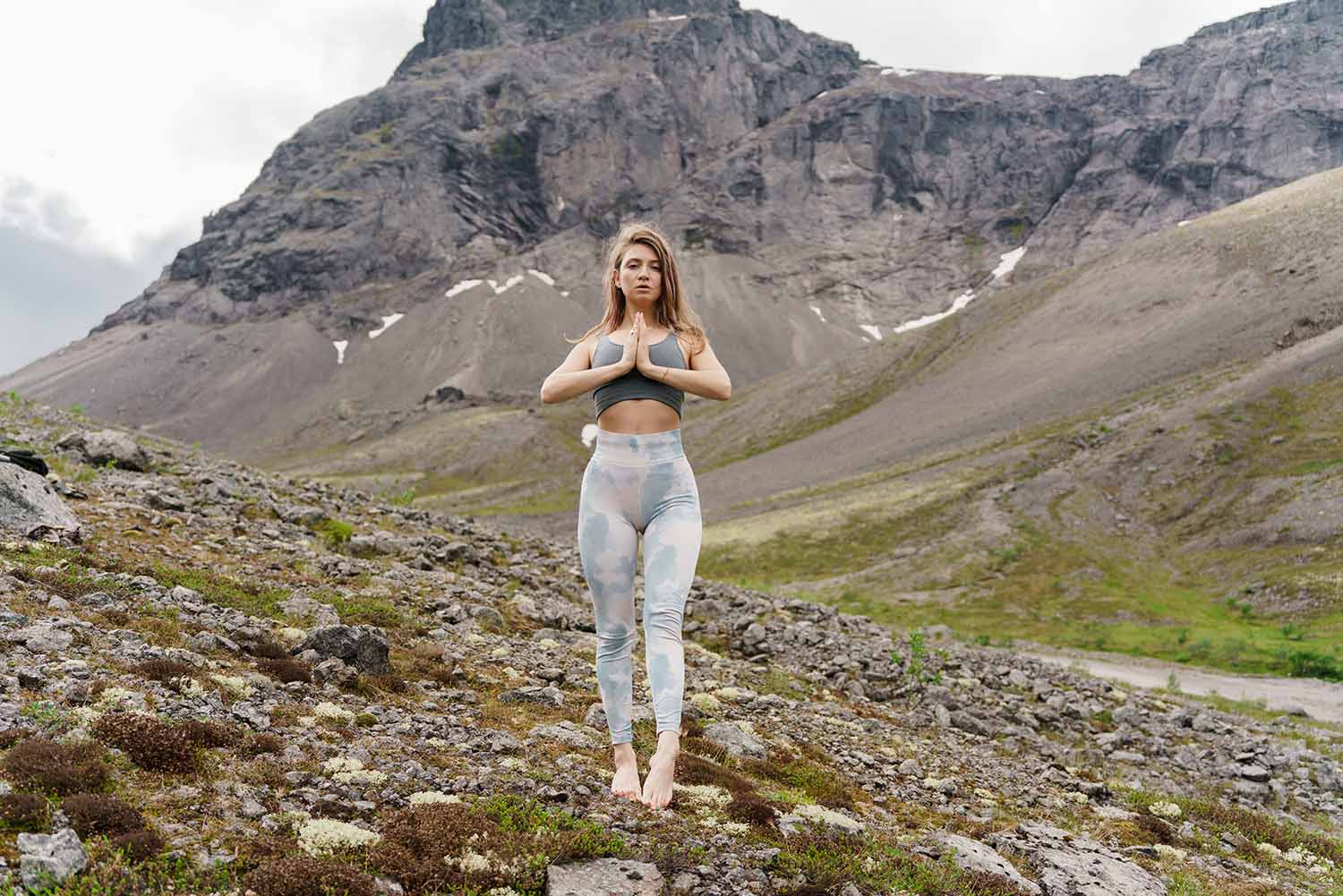One of the most fundamental yoga poses – Mountain Pose in yoga, or Tadasana in Sanskrit, is a seemingly simple posture that holds the key to developing the foundation of your yoga practice.
Other Names for Mountain Pose Yoga Pose
Mountain Pose is known by several names in various yoga traditions and languages. Some of the common alternate names for Mountain Pose include:
- Tadasana (Sanskrit)
- Samasthiti
- Samasthitihi
How to do Mountain Pose Pose in Yoga
Mountain Pose may seem straightforward, but perfecting it is a crucial step in your yoga practice. Here’s a step-by-step guide:
- Stand at the front of your mat with your feet together or hip-distance apart. Keep your arms at your sides and your palms facing forward.
- Distribute your weight evenly across both feet. Ground your feet into the mat, engaging all parts of your foot.
- Engage your leg muscles, pulling your kneecaps up, and firm your thigh muscles.
- Lengthen your spine, drawing your tailbone down toward the ground. Lift your chest and broaden your collarbones.
- Keep your shoulders relaxed and away from your ears, with your arms hanging by your sides.
- Gaze forward, fixing your eyes on a point in front of you.
- Breathe deeply and evenly, holding the pose for 30 seconds to a minute.
Variations of Mountain Pose Yoga Pose
While Mountain Pose itself is relatively simple, there are variations that can help you deepen your practice:
- Raised Arms Mountain Pose: Inhale as you raise your arms overhead, bringing your palms to touch. This variation extends the stretch through the arms and sides of the body.
- Heel Lift Mountain Pose: Lift your heels slightly off the mat, maintaining balance on the balls of your feet. This variation increases ankle strength and stability.
Modifications for Mountain Pose Yoga Pose
While Mountain Pose itself is relatively simple, there are variations that can help you deepen your practice:
- Raised Arms Mountain Pose: Inhale as you raise your arms overhead, bringing your palms to touch. This variation extends the stretch through the arms and sides of the body.
- Heel Lift Mountain Pose: Lift your heels slightly off the mat, maintaining balance on the balls of your feet. This variation increases ankle strength and stability.
Contraindications for Mountain Pose Pose in Yoga
Mountain Pose is generally safe for most practitioners. However, individuals with severe back issues or injuries may need to be cautious about the alignment and the arching of the lower back in this pose. It’s advisable to consult with a yoga instructor or healthcare professional if you have concerns about your suitability for this pose.
Tips to improve Mountain Pose yoga pose in your practice
- Mindful Alignment: Pay close attention to the alignment of your body, from the feet to the crown of your head.
- Use a Mirror: Practicing in front of a mirror can be beneficial to self-correct your alignment.
- Breathe Deeply: Focus on deep, rhythmic breathing to enhance your presence in the pose.
- Engage All Muscles: Ensure that you engage all your muscles, from your feet and legs to your core and shoulders.
What Muscles Does Mountain Pose Pose Work?
Mountain Pose is a foundational yoga pose that engages various muscle groups:
- Legs: It strengthens the quadriceps, calves, and ankles.
- Core: Engages the abdominal muscles and helps improve posture.
- Back: Promotes an elongated spine, engaging the muscles of the back.
- Shoulders: Encourages relaxation of the shoulder muscles.
Mental and Emotional Benefits of Mountain Pose Pose in Yoga?
Mountain Pose extends beyond the physical realm, offering mental and emotional benefits:
- Grounding: It helps you connect with the Earth, fostering a sense of stability and groundedness.
- Centering: Mountain Pose encourages emotional balance and a sense of centeredness.
- Mindfulness: Practicing this pose can enhance your ability to be fully present in the moment.
Is Mountain Pose Yoga pose suitable for beginners?
Mountain Pose is ideal for beginners as it serves as the foundation for many other yoga poses. It provides an opportunity to practice proper alignment and mindfulness.
Is Mountain Pose Yoga pose suitable for advanced practitioners?
Although Mountain Pose may appear basic, it remains a valuable component of advanced practices. Advanced practitioners can use this pose to refine their alignment and focus on subtle nuances.
How does Mountain Pose pose contribute to a yoga sequence or flow?
Mountain Pose is often used as a starting point in many yoga sequences. It serves several functions:
- Establishing Alignment: It provides an opportunity to align the body and mind at the beginning of a practice.
- Transitions: It acts as a transition pose, allowing you to move seamlessly into other poses.
- Stillness: Mountain Pose offers a moment of stillness and mindfulness during a practice.
How can I deepen my practice in Mountain Pose pose?
To deepen your practice in Mountain Pose, consider the following:
- Work on Alignment: Focus on the subtle details of alignment, such as the placement of your feet and the extension of your spine.
- Visualize the Mountain: Imagine yourself as a tall, majestic mountain, rooted and unwavering.
- Connect with Your Breath: Pay attention to your breath and use it to deepen your sense of presence in the pose.
What are some common mistakes in teaching Mountain Pose Yoga Pose?
As a yoga teacher, it’s essential to avoid common teaching mistakes, such as:
- Inadequate Alignment Instruction: Providing insufficient guidance on alignment can lead to improper form.
- Neglecting Individual Variations: Not acknowledging that students have different body types and abilities can hinder their experience.
- Overlooking Breath Awareness: Failing to emphasize the connection between breath and movement can diminish the mindfulness aspect of the pose.
- Rushing Through Transitions: Encouraging rushed transitions can lead to misalignment and disrupt the flow of the practice.
- Neglecting Hands-On Assistance: Not offering hands-on adjustments when necessary can deprive students of valuable feedback.
- Monotonous Teaching: Using the same cues repeatedly can lead to boredom and lack of engagement.
- Lack of Adaptability: Failing to adjust the pose based on the students’ abilities can result in a mismatch and disengagement.
In conclusion, Mountain Pose (Tadasana) is the foundation of many yoga practices, offering numerous physical, mental, and emotional benefits. It is suitable for both beginners and advanced practitioners, as it lays the groundwork for proper alignment and mindfulness. As a yoga teacher or practitioner, focusing on alignment, variations, and the mental aspects of this pose can deepen the experience and enhance its role in your practice. Through mindfulness and proper guidance, the seemingly simple Mountain Pose can become a powerful tool in your yoga journey.
Namaste.
Who should not do mountain pose?
Mountain Pose, or Tadasana, should be avoided by individuals with low blood pressure, severe vertigo, or recent leg, ankle, or spine injuries. Since this foundational yoga pose emphasizes alignment, balance, and grounding—key aspects in practices like Hatha Yoga and Vinyasa Flow—any condition affecting stability or posture may increase the risk of strain or discomfort.
What is the Mountain Pose good for?
Mountain Pose, also known as Tadasana, is good for improving posture, enhancing balance, and increasing body awareness. It serves as a foundational yoga pose in practices like Hatha and Vinyasa yoga, helping align the spine, engage core muscles, and cultivate mindful breathing.
Which yoga is best for diabetes?
The best yoga for diabetes includes poses that help improve insulin sensitivity and lower blood sugar levels. Key practices include Mountain Pose (Tadasana), Downward-Facing Dog (Adho Mukha Svanasana), and Seated Forward Bend (Paschimottanasana), which support stress reduction and stimulate pancreatic function.
What are common mistakes in Mountain Pose?
Common mistakes in Mountain Pose include locking the knees, arching the lower back, and letting the shoulders lift toward the ears. Proper alignment in Tadasana requires engaging the quadriceps, grounding through the feet (as in Iyengar Yoga), and maintaining a neutral spine using core support.
Can Mountain Pose relieve back pain?
Mountain Pose can help relieve back pain by promoting proper posture, engaging the core, and improving spinal alignment. As a foundational yoga pose in practices like Hatha and Vinyasa yoga, it activates muscles in the back, legs, and abdomen, encouraging balance and reducing strain on the lower back.

